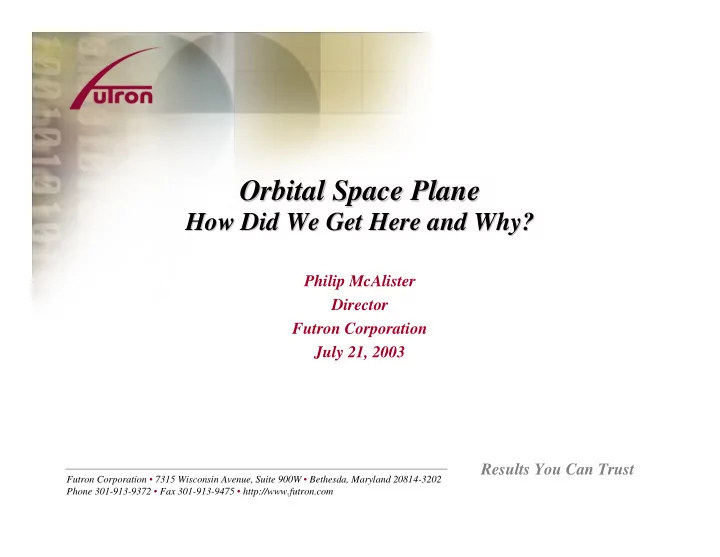

Orbital Space Plane Orbital Space Plane How Did We Get Here and Why? How Did We Get Here and Why? Philip McAlister Director Futron Corporation July 21, 2003 Results You Can Trust Futron Corporation • 7315 Wisconsin Avenue, Suite 900W • Bethesda, Maryland 20814-3202 Phone 301-913-9372 • Fax 301-913-9475 • http://www.futron.com
Background Background • By the mid-1990s, a consensus emerged among policy makers and OMB that the nation would need a successor to the Space Shuttle, which is costly to fly, difficult to maintain, and prone to disaster • After a competitive procurement, NASA selected a very advanced technology design by Lockheed Martin for the centerpiece X-33 program » Single stage to orbit (SSTO) » Aerospike engines » Composite propellant tanks » Precursor to a commercial vehicle dubbed VentureStar 2
X- -33 33 X • Originally, 15 flights were to be completed by 1999, enabling NASA to decide whether to proceed with VentureStar by 2000 • While good progress was made on the aerospike engines, the composite fuel tank failed, commercial market forecasts declined, and cost estimates began to increase dramatically • The goals of the program were significantly scaled back; then, in 2001, NASA cancelled the X-33 program and the partially complete vehicle was dismantled • OMB and Congress gave NASA a “mulligan” – NASA was given another five years of RLV development under the auspices of the Space Launch Initiative (SLI) 3
Space Launch Initiative Space Launch Initiative • SLI was a comprehensive plan to dramatically increase the safety, reliability, and affordability of space transportation • SLI was well funded ($4.5B through mid-decade) • The 2 nd Generation RLV became the centerpiece of SLI (the Space Shuttle being the 1 st Generation RLV) » Privately operated and commercially available » Reduce the cost to orbit to less than $1,000/lb (was $10,000/lb) » Reduce the probability of crew loss to less than one in 10,000 flights (was one in 300) » Significant focus on technology development, along with three vehicle design contracts 4
nd Generation RLV 2 nd Generation RLV 2 • The goals were very ambitious and the timeline was short – a decision on vehicle development was planned by 2006 and operations were to begin by 2010 • Concerns begin to emerge » Commercial forecasts continued to decline » Cost realism and budget availability questioned » Political support began to falter • In the Fall of 2002, with a Systems Requirements Review just a couple months away, a reassessment was undertaken at NASA HQ 5
Orbital Space Plane Orbital Space Plane • In November 2002, via a 2003 budget amendment, NASA restructured SLI, with OSP as the centerpiece » 2 nd Generation RLV Program cancelled » Focus is on an ISS crew transport vehicle (Orbital Space Plane) • Using existing technology • No requirement to fly commercial satellites » EELV used as the booster for OSP » Shuttle will continue to fly in parallel with OSP for some period of time » Continued funding for breakthrough technology via the Next Generation Launch Technology (NGLT) program 6
Lessons Learned Lessons Learned • In the X-33 program, and, to a lesser extent, in the SLI program, NASA placed a heavy emphasis on commercial involvement and launch demand in sizing its vehicles and projecting cost amortization • X-33 and SLI coupled new RLV booster design with crew transport capability, essentially putting one risky system on the critical path of another • VentureStar and 2 nd Generation RLV were both wholesale replacements for the Shuttle 7
OSP Rationale OSP Rationale • Relies on existing technology which lowers the risk, is more affordable, and enables a vehicle to be fielded sooner • Work will continue on advanced technologies which promise lower costs and increased reliability in the longer term • Leverages the DOD-paid-for EELV boosters • Increases the demand for EELVs • OSP is tightly coupled to Shuttle and ISS • OSP flight rate and, hence, costs are not based upon future commercial demand • OSP will serve as the ISS “lifeboat” thus reducing reliance on the Russian Soyuz vehicle 8
Recommend
More recommend